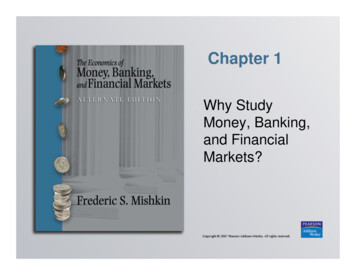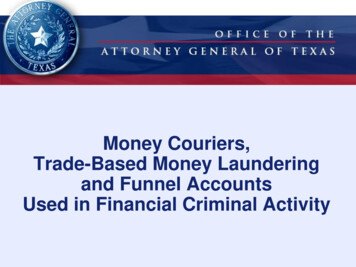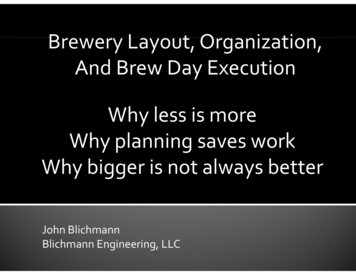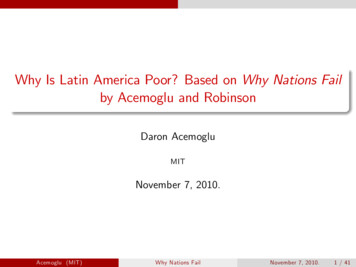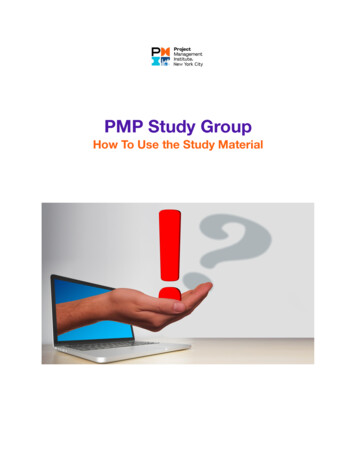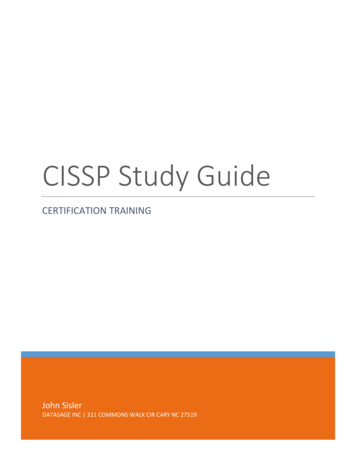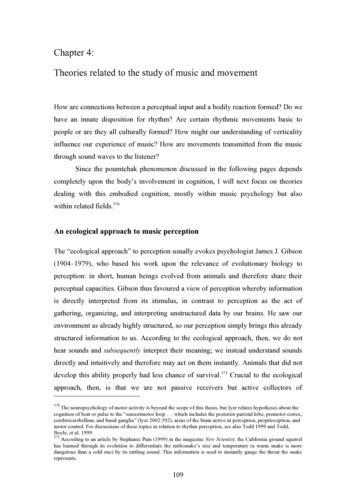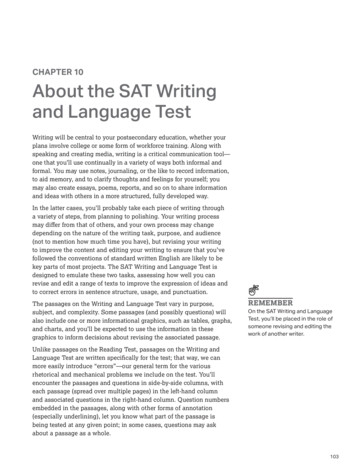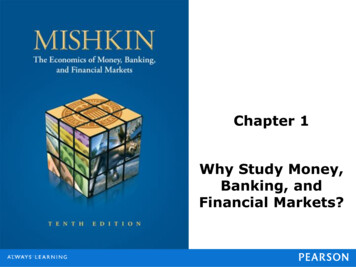
Transcription
Chapter 1Why Study Money,Banking, andFinancial Markets?
Preview To examine how financial markets such as bond,stock and foreign exchange markets work To examine how financial institutions such asbanks, investment and insurance companies work To examine the role of money in the economy1-2 2013 Pearson Education, Inc. All rights reserved.
Why Study Financial Markets? Financial markets are markets in whichfunds are transferred from people andFirms who have an excess of availablefunds to people and Firms who have aneed of funds1-3 2013 Pearson Education, Inc. All rights reserved.
The Bond Market and InterestRates A security (financial instrument) is aclaim on the issuer’s future income orassets. A bond is a debt security that promises tomake payments periodically for aspecified period of time. An interest rate is the cost of borrowingor the price paid for the rental of funds.1-4 2013 Pearson Education, Inc. All rights reserved.
Figure 1 Interest Rates on SelectedBonds, 1950–2011Sources: Based on Federal Reserve htm.1-5 2013 Pearson Education, Inc. All rights reserved.
The Stock Market Common stock represents a share ofownership in a corporation A share of stock is a claim on the residualearnings and assets of the corporation1-6 2013 Pearson Education, Inc. All rights reserved.
Why Study Financial Institutionsand Banking? Financial Intermediaries: institutions thatborrow funds from people who have savedand make loans to other people:– Banks: accept deposits and make loans– Other Financial Institutions: insurancecompanies, finance companies, pension funds,mutual funds and investment companies Financial Innovation: the development ofnew financial products and services– Can be an important force for good by makingthe financial system more efficient1-7 2013 Pearson Education, Inc. All rights reserved.
Figure 2 Stock Prices as Measured bythe Dow Jones Industrial Average,1950–2011Source: Based on Dow Jones Indexes: http://nance.yahoo.com/?u.1-8 2013 Pearson Education, Inc. All rights reserved.
Financial Crises Financial crises are major disruptions infinancial markets that are characterized bysharp declines in asset prices and thefailures of many financial and nonfinancialfirms.1-9 2013 Pearson Education, Inc. All rights reserved.
Why Study Money and MonetaryPolicy? Evidence suggests that money plays animportant role in generating business cycles Recessions (unemployment) and expansionsaffect all of us Monetary Theory ties changes in the moneysupply to changes in aggregate economicactivity and the price level1-10 2013 Pearson Education, Inc. All rights reserved.
Money, Business Cycles andInflation The aggregate price level is the averageprice of goods and services in an economy A continual rise in the price level (inflation)affects all economic players Data shows a connection between themoney supply and the price level1-11 2013 Pearson Education, Inc. All rights reserved.
Figure 3 Money Growth (M2 AnnualRate) and the Business Cycle in theUnited States 1950–2011Source: Based on Federal Reserve Bulletin, p. A4, Table t1.txt.1-12 2013 Pearson Education, Inc. All rights reserved.
Figure 4 Aggregate Price Level andthe Money Supply in the UnitedStates, 1950–2011Sources: Based on eserve.gov/releases/h6/hist/h6hist10.txt.1-13 2013 Pearson Education, Inc. All rights reserved.
Figure 5 Average Inflation RateVersus Average Rate of MoneyGrowth for Selected Countries, 20002010Source: Based on International Financial Statistics. www.imfstatistics.org/imf.1-14 2013 Pearson Education, Inc. All rights reserved.
Money and Interest Rates Interest rates are the price of money Prior to 1980, the rate of money growthand the interest rate on long-term Treasurybonds were closely tied Since then, the relationship is less clear butthe rate of money growth is still animportant determinant of interest rates1-15 2013 Pearson Education, Inc. All rights reserved.
Figure 6 Money Growth (M2 AnnualRate) and Interest Rates (Long-TermU.S. Treasury Bonds), 1950–2011Sources: Based on Federal Reserve Bulletin, p. A4, Table t1.txt.1-16 2013 Pearson Education, Inc. All rights reserved.
Fiscal Policy and Monetary Policy Monetary policy is the management of the moneysupply and interest rates– Conducted in the U.S. by the Federal Reserve System(Fed) Fiscal policy deals with government spendingand taxation– Budget deficit is the excess of expenditures overrevenues for a particular year– Budget surplus is the excess of revenues overexpenditures for a particular year– Any deficit must be financed by borrowing1-17 2013 Pearson Education, Inc. All rights reserved.
Figure 7 Government Budget Surplusor Deficit as a Percentage of GrossDomestic Product, 1950–2010Source: s.1-18 2013 Pearson Education, Inc. All rights reserved.
The Foreign Exchange Market The foreign exchange market is wherefunds are converted from one currency intoanother The foreign exchange rate is the price ofone currency in terms of another currency The foreign exchange market determinesthe foreign exchange rate1-19 2013 Pearson Education, Inc. All rights reserved.
Figure 8 Exchange Rate of theU.S. Dollar, 1970–2011Source: Federal Reserve; c m.txt/.1-20 2013 Pearson Education, Inc. All rights reserved.
The International FinancialSystem Financial markets have become increasinglyintegrated throughout the world. The international financial system hastremendous impact on domestic economies:– How a country’s choice of exchange rate policyaffect its monetary policy?– How capital controls impact domestic financialsystems and therefore the performance of theeconomy?– Which should be the role of internationalfinancial institutions like the IMF?1-21 2013 Pearson Education, Inc. All rights reserved.
How We Will Study Money,Banking, and Financial Markets A simplified approach to the demand forassets The concept of equilibrium Basic supply and demand to explainbehavior in financial markets The search for profits An approach to financial structure based ontransaction costs and asymmetricinformation Aggregate supply and demand analysis1-22 2013 Pearson Education, Inc. All rights reserved.
Figure 9 Federal Reserve BoardWebsiteSource: www.federalreserve.gov/releases/H15.1-23 2013 Pearson Education, Inc. All rights reserved.
Figure 10 Excel Spreadsheetwith Interest-Rate Data1-24 2013 Pearson Education, Inc. All rights reserved.
Figure 11 Excel Graph ofInterest-Rate Data1-25 2013 Pearson Education, Inc. All rights reserved.
How We Will Study Money, Banking, and Financial Markets A simplified approach to the demand for assets The concept of equilibrium Basic supply and demand to explain behavior in financial markets The search for profits An approach to financial structure based on

